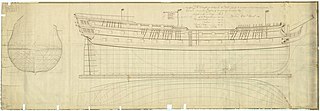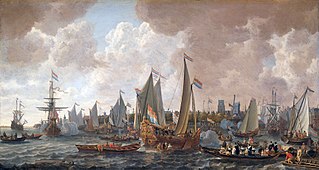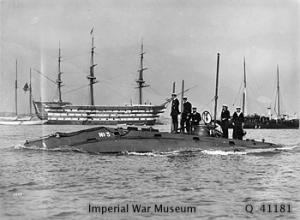
In the United Kingdom, a scheduled monument is a nationally important archaeological site or historic building, given protection against unauthorised change.

In the United Kingdom, a listed building is a structure of particular architectural and/or historic interest deserving of special protection. Such buildings are placed on one of the four statutory lists maintained by Historic England in England, Historic Environment Scotland in Scotland, Cadw in Wales, and the Northern Ireland Environment Agency in Northern Ireland. The classification schemes differ between England and Wales, Scotland, and Northern Ireland. The term has also been used in the Republic of Ireland, where buildings are protected under the Planning and Development Act 2000, although the statutory term in Ireland is "protected structure."

HMS Colossus was a 74-gun third-rate ship of the line of the Royal Navy. She was launched at Gravesend on 4 April 1787 and lost on 10 December 1798. During her years of service she participated in the Battle of Groix, the Battle of Cape St Vincent, and the Battle of the Nile. While carrying wounded from the latter, she was wrecked at the Isles of Scilly. The wreck is a Protected Wreck managed by Historic England.

HMY Mary was the first Royal Yacht of the Royal Navy. She was built in 1660 by the Dutch East India Company. Then she was purchased by the City of Amsterdam and given to King Charles II, on the restoration of the monarchy, as part of the Dutch Gift. She struck rocks off Anglesey in thick fog on 25 March 1675 while en route from Dublin to Chester. Although 35 of the 74 crew and passengers were killed as the wreck quickly broke up, 39 managed to get to safety. The remains were independently discovered by two different diving groups in July 1971. After looters started to remove guns from the site, a rescue operation was organized and the remaining guns and other artifacts were taken to the Merseyside Museums for conservation and display. After the passing of the Protection of Wrecks Act 1973, she was designated as a protected site on 20 January 1974.

HMS Resolution was a 70-gun third-rate ship of the line of the Royal Navy, launched at Harwich Dockyard on 6 December 1667. She was one of only three third-rate vessels designed and built by the noted maritime architect Sir Anthony Deane.

The Protection of Military Remains Act 1986 is an Act of the Parliament of the United Kingdom that provides protection for the wreckage of military aircraft and designated military vessels. The Act provides for two types of protection: protected places and controlled sites. Military aircraft are automatically protected, but vessels have to be specifically designated. The primary reason for designation is to protect as a 'war grave' the last resting place of British servicemen ; however, the Act does not require the loss of the vessel to have occurred during war.

Hanover was a two-masted brigantine packet ship owned and operated by the Falmouth Post Office Packet Service, which operated between 1688 and 1852.

The Salcombe Cannon wrecksite is close to two other designated wrecksites in the Erme Estuary which the South West Maritime Archaeological Group (SWMAG) was licensed to investigate. In 1992 this group described the Salcombe Cannon site as:

Holland 5 was the last of the five Holland-class submarines ordered by the British Admiralty to evaluate the potential of the submarine with the Royal Navy. She was one of the first submarines to be accepted into Royal Navy service, and unique to her class, she carried one of the earliest periscopes. By the time she was launched, a number of A-class submarines had already been ordered to replace this class in navy service.

The Seaton Carew Wreck is a protected wrecksite lying in the intertidal zone at Seaton Carew. Prior to 1996 the wreck had been completely covered by the sand of the beach, but it was exposed in 1996 and 2002 and has been regularly exposed since 2004. The wreck is of a type of vessel known as a collier brig which would have been ubiquitous in the 18th and 19th centuries and is unusual on the North-East coast for the high degree of preservation. The wreck is a Protected Wreck managed by Historic England.
St Anthony or Santo António was a Portuguese carrack that foundered in Gunwalloe Bay, Cornwall, in 1527 en route from Lisbon to Antwerp. She had a mixed cargo including copper and silver ingots. The wreck was recorded historically, because the salvage of the cargo was the subject of an international dispute that led to a Court of Star Chamber, but the location of the wreck was unknown until 1981. The wreck is designated under the Protection of Wrecks Act and is managed by Historic England.
The Diamond was a three-masted square rigger, built in New York City in 1823. She was one of the first ships to operate a regular service for passenger and cargo between Britain and the United States. She sank en route to Liverpool from New York on 2 January 1825 in Cardigan Bay. The alleged wreck site was identified in 2000 and was designated under the Protection of Wrecks Act 1973 on 1 April 2002, the first such designation by the National Assembly for Wales. However, the identification has since been called into question.
The Wheel Wreck is the remains of a shipwreck lying in Crow sound off Little Ganinick in the Isles of Scilly. The wreck site consists of a discrete mound of cargo that appears to consist of numerous sizes of different iron wheels, cogs, clack valves, tubes and boiler pipes. Lead scupper pipes and other small artefact material show the ship was once present, however, not much remains of this vessel today. A Trotmann style anchor lies some 60m from the site, and this along with the cargo, date the site as sometime just after 1835. It has been published that this may be the wreck of the Padstow, however, being lost in 1804 this can not be so as neither boiler tubes or Trotmann anchors were invented back then. The wreck was discovered by local diver Todd Stevens in 2005 and investigated by the archaeological contractor for the Protection of Wrecks Act 1973 in 2006. It still remains unidentified. However it is most likely to be a ship called the 'Plenty' which is recorded locally as having sank- "within 1 mile of the principal island" -in 1840.
Historic England is an executive non-departmental public body of the British Government sponsored by the Department for Culture, Media and Sport. It is tasked with protecting the historic environment of England by preserving and listing historic buildings, scheduling ancient monuments, registering historic parks and gardens and by advising central and local government.
HMS Swallow was a brig-sloop of the Royal Navy, built by Richard Symons, Little Falmouth as the packet ship Marquis of Salisbury for Captain Sutton, launched in 1819 and acquired by the Royal Navy in July 1824.
Maritime Archaeology Sea Trust (MAST) is a charitable trust founded in February 2011, which focuses on investigations into the maritime heritage of the United Kingdom and further afield, through historical and archaeological investigations. MAST uses its profits from contract work as well as donations to fund its charitable aims.
Between 1991-1992 an archaeological site containing tin ingots was uncovered close to West Mary's Rocks in Devon, England. Examination of the site revealed that these ingots may represent a wreck site, or the lost cargo from a ship. The ingots are believed to have been made before 1000 BC, during the later stages of the British Bronze Age. The site was designated under the Protection of Wrecks Act on 24 November 1993. The wreck is a Protected Wreck managed by Historic England. The ingots found here are an important source of knowledge for prehistoric tin.

The remains of a wreck carrying cargo of Middle Bronze Age weapons was found in 1977 off Moor Sand, Gammon Head, South Hams, Devon, England. The site was designated under the Protection of Wrecks Act on 14 February 1978. The wreck is a Protected Wreck managed by Historic England










